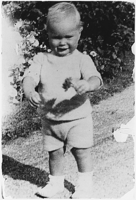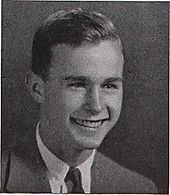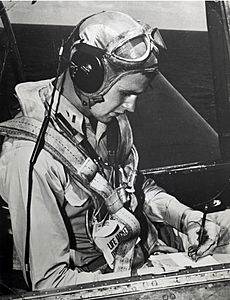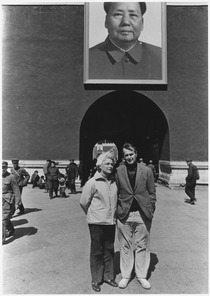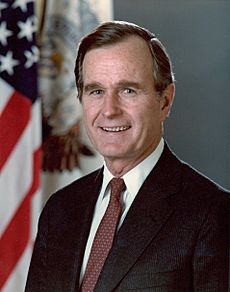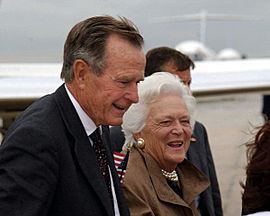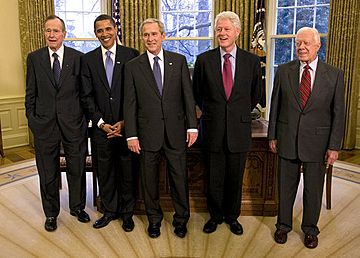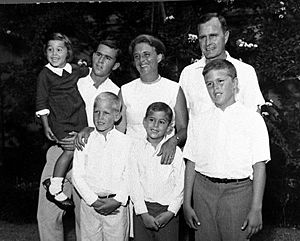George H. W. Bush facts for kids
Quick facts for kids
George H. W. Bush
|
|
|---|---|
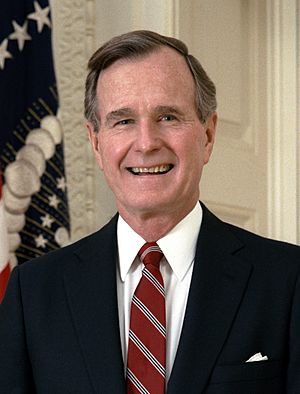
Official portrait, 1989
|
|
| 41st President of the United States | |
| In office January 20, 1989 – January 20, 1993 |
|
| Vice President | Dan Quayle |
| Preceded by | Ronald Reagan |
| Succeeded by | Bill Clinton |
| 43rd Vice President of the United States | |
| In office January 20, 1981 – January 20, 1989 |
|
| President | Ronald Reagan |
| Preceded by | Walter Mondale |
| Succeeded by | Dan Quayle |
| 11th Director of Central Intelligence | |
| In office January 30, 1976 – January 20, 1977 |
|
| President | Gerald Ford |
| Deputy |
|
| Preceded by | William Colby |
| Succeeded by | Stansfield Turner |
| 2nd Chief of the U.S. Liaison Office to the People's Republic of China | |
| In office September 26, 1974 – December 7, 1975 |
|
| President | Gerald Ford |
| Preceded by | David K. E. Bruce |
| Succeeded by | Thomas S. Gates Jr. |
| Chair of the Republican National Committee | |
| In office January 19, 1973 – September 16, 1974 |
|
| Preceded by | Bob Dole |
| Succeeded by | Mary Smith |
| 10th United States Ambassador to the United Nations | |
| In office March 1, 1971 – January 18, 1973 |
|
| President | Richard Nixon |
| Preceded by | Charles Yost |
| Succeeded by | John A. Scali |
| Member of the U.S. House of Representatives from Texas's 7th district |
|
| In office January 3, 1967 – January 3, 1971 |
|
| Preceded by | John Dowdy |
| Succeeded by | Bill Archer |
| Personal details | |
| Born |
George Herbert Walker Bush
June 12, 1924 Milton, Massachusetts, U.S. |
| Died | November 30, 2018 (aged 94) Houston, Texas, U.S. |
| Resting place | George H.W. Bush Presidential Library and Museum |
| Political party | Republican |
| Spouse | |
| Children | |
| Parent |
|
| Relatives | Bush family |
| Education | Yale University (BA) |
| Occupation |
|
| Awards | Full list |
| Signature | |
George Herbert Walker Bush (born June 12, 1924 – died November 30, 2018) was an American leader, diplomat, and businessman. He served as the 41st president of the United States from 1989 to 1993. Before becoming president, he was the 43rd vice president from 1981 to 1989 under Ronald Reagan. He also held many other important jobs in the government.
Many historians consider Bush to have been an above-average president.
Early Life and Education
-
Bush at his grandfather's house in Kennebunkport, c. 1925
George Herbert Walker Bush was born on June 12, 1924, in Milton, Massachusetts. He was the second son of Prescott Bush and Dorothy (Walker) Bush. His family was wealthy, so the Great Depression did not affect him much.
Bush spent most of his childhood in Greenwich, Connecticut. He also spent time at his family's vacation home in Kennebunkport, Maine. He went to Greenwich Country Day School and then to Phillips Academy, a private school in Massachusetts. At Phillips Academy, he was a leader. He was president of his senior class and captain of the baseball and soccer teams.
Serving in World War II
On his 18th birthday, right after finishing high school, Bush joined the United States Navy. He became one of the youngest pilots in the Navy. In 1944, he served in the Pacific Ocean during World War II. He flew a Grumman TBF Avenger, which was a type of plane that could take off from aircraft carriers.
During a mission, Bush's plane was hit by enemy fire. His two fellow crew members died, but Bush managed to parachute out. He was rescued by a submarine. This experience deeply affected him. He later received the Distinguished Flying Cross for his bravery.
Bush continued to fly missions until Japan surrendered in September 1945. He was released from active duty that month. By the end of his service, he had flown 58 missions.
College Life and Business Career
After the war, Bush went to Yale College. He finished his degree in two and a half years. He played baseball for Yale and was captain of the team. He also joined a secret society called Skull and Bones. In 1948, he graduated with a degree in economics.
After college, Bush moved his family to West Texas. He started working in the oil business. In 1953, he helped start the Zapata Petroleum Corporation, an oil company. He later became president of Zapata Offshore Company, which focused on offshore drilling. Bush stayed with Zapata until the mid-1960s.
Early Political Career
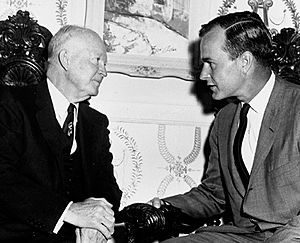
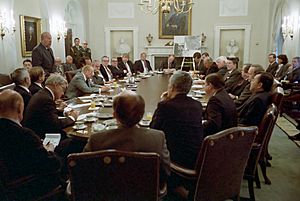
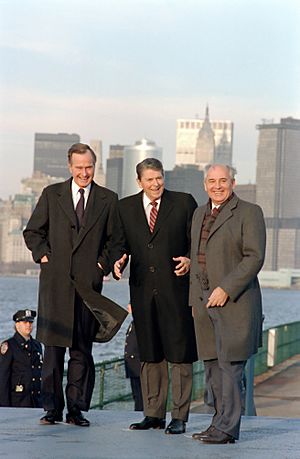
Bush first ran for the U.S. Senate in 1964 but lost. However, in 1966, he was elected to represent Texas's 7th congressional district in the House of Representatives.
He held many important roles in the government:
- In 1971, President Richard Nixon made him the ambassador to the United Nations.
- In 1973, he became chairman of the Republican National Committee.
- In 1974, President Gerald Ford appointed him as the U.S. representative to China.
- In 1976, he became the director of Central Intelligence (head of the CIA).
In 1980, Bush ran for president but lost the Republican nomination to Ronald Reagan. Reagan then chose Bush to be his running mate for vice president. As vice president, Bush worked closely with Reagan and earned his trust.
In the 1988 presidential election, Bush ran for president again and won, defeating Democrat Michael Dukakis.
Presidency (1989–1993)
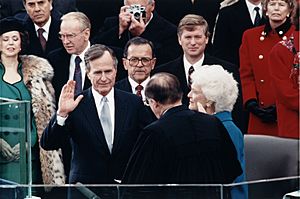

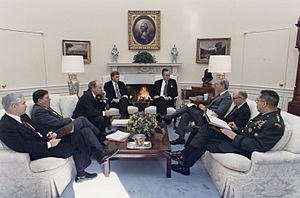
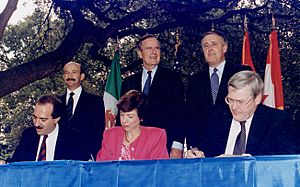
During Bush's presidency, foreign policy was very important. He guided the U.S. through the end of the Cold War. He also played a key role in the reunification of Germany.
He led the invasion of Panama. He also led the Gulf War, which ended Iraq's occupation of Kuwait. Bush also worked on the North American Free Trade Agreement (NAFTA). This agreement created a trade partnership between the United States, Canada, and Mexico.
At home, Bush signed important laws. He supported and signed the Americans with Disabilities Act in 1990. This law helps protect people with disabilities from unfair treatment. He also signed the Clean Air Act Amendments to help protect the environment.
Helping People with Disabilities
Before Bush's presidency, people with disabilities often faced discrimination. In 1990, Bush signed the Americans with Disabilities Act of 1990 into law. This act made it illegal to discriminate against qualified people with disabilities in jobs and public places. It required businesses to make "reasonable accommodations" for disabled people. Bush strongly supported this law, partly because his son, Neil, had dyslexia.
Bush also signed the Civil Rights Act of 1991. This law helped people who faced discrimination in their jobs. In 1990, he signed the Ryan White CARE Act. This program helped people living with HIV/AIDS.
Protecting Our Environment
In 1989, Bush proposed changes to the Clean Air Act. These changes aimed to reduce acid rain and smog by lowering chemical emissions. This was the first major update to the Clean Air Act since 1977. Bush also signed the Oil Pollution Act of 1990. This law was passed after a large oil spill from the Exxon Valdez ship.
Points of Light Initiative
Bush believed that people helping each other could solve many problems. He often spoke about "a thousand points of light." This phrase described all the community groups and volunteers across the nation doing good things. During his time as president, Bush honored many volunteers with the Daily Point of Light Award. This tradition continued after he left office. In 1990, the Points of Light Foundation was created to encourage volunteerism.
After the Presidency (1993–2018)
Bush lost the 1992 presidential election to Democrat Bill Clinton. After leaving office in 1993, Bush stayed active in helping others. He often worked with Bill Clinton on humanitarian projects.
His son, George W. Bush, became the 43rd president in 2000. This made them the second father-son pair to both serve as president. The first pair was John Adams and John Quincy Adams. Another son, Jeb Bush, also ran for president in 2016 but did not win the nomination.
Death and Funeral
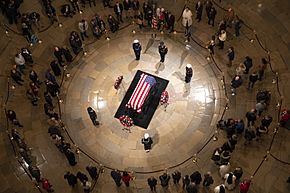
George H. W. Bush passed away at his home in Houston on November 30, 2018. He was 94 years old. At the time, he was the longest-lived U.S. president.
His body was placed in the Rotunda of the U.S. Capitol for people to pay their respects. This is a special honor given to important leaders. A state funeral was held at Washington National Cathedral. After the funeral, Bush was buried next to his wife Barbara and daughter Robin in Texas. His son, George W. Bush, spoke at the funeral, saying his father "looked for the good in each person, and he usually found it."
Personal Life
Bush met Barbara Pierce at a Christmas dance in 1941. They got engaged in 1943 and married on January 6, 1945. They had a strong marriage, and Barbara was a very popular First Lady. Many people saw her as "a kind of national grandmother."
They had six children:
- George W. (born 1946)
- Robin (1949–1953), who sadly died of leukemia
- Jeb (born 1953)
- Neil (born 1955)
- Marvin (born 1956)
- Doro (born 1959)
Memorials and Honors
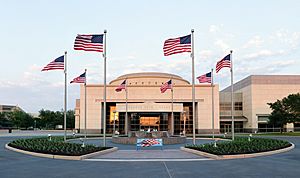
Many places and things have been named in honor of George H. W. Bush:
- In 1990, Time magazine named him the Man of the Year.
- In 1997, the Houston Intercontinental Airport was renamed the George Bush Intercontinental Airport.
- In 1999, the CIA headquarters was named the George Bush Center for Intelligence.
- In 2011, Bush, who loved golf, was inducted into the World Golf Hall of Fame.
- A U.S. Navy aircraft carrier, the USS George H.W. Bush (CVN-77), was named after him.
- In 2019, the United States Postal Service issued a postage stamp in his honor.
The George H.W. Bush Presidential Library and Museum opened in 1997. It holds his presidential and vice presidential papers. It is located at Texas A&M University in College Station, Texas. The university also has the Bush School of Government and Public Service, a school for public policy.
See Also
 In Spanish: George H. W. Bush para niños
In Spanish: George H. W. Bush para niños
- Electoral history of George H. W. Bush
- List of presidents of the United States


